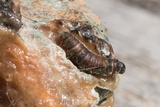Anarsia lineatella Zeller, 1839 Species
Last modified: Jan. 5, 2024, 10:55 a.m.
In the past it was assumed that it was only one species, but since the publication of Keld Gregersen and Ole Karsholt in Nota Lepidopterologica 40(1):65–85, Taxonomic confusion around the Peach Twig Borer, Anarsia lineatella Zeller, 1839, with description of a new species (Lepidoptera, Gelechiidae) , we know that there are 2 species involved.
The first confirmed observation after 1980 is of a caterpillar found in a peach, origin from Spain, and bought in a supermarket in Zemst (VB) on 30.vi.2023.
Details
- Classification
- Family: Gelechiidae > Subfamily: Anacampsinae > Tribus: Chelariini > Genus: Anarsia > Species: Anarsia lineatella
- Vernacular names
- Perzikscheutboorder (NL), Peach Twig Borer (EN), Pfirsich-Palpenfalter, Pfirsichmotte (DE)
- First mention in Belgium
- De Crombrugghe G. 1906a. Catalogue raisonné des Microlépidoptères de Belgique. — Mémoires de la Société entomologique de Belgique XIII: 1–172; XIV: 1–155. On page 38.
- Status
-
Native
Distribution
Imago
Wingspan 11–14 mm.
Museum specimens
No pictures yet!Specimens in nature
No pictures yet!Egg
Yellowish eggs and measure 0.3 to 0.5 mm. They are deposited singly or in groups on flower buds, petioles and young fruit, on the bark, depending on the time of year.
Cocoon/pupa
Brown pupae.
Bionomics
The caterpillars usually first feed on terminal growth of twigs, later moving to fruits shortly after the pits start to harden. It overwinters as a partially grown caterpillar, protected in a small silk-covered cell on the bark of fruit trees. Later they pupate on the trunk and larger branches.
Flight periods
The adults are on the wing from May towards early September.
Observed on
The larva lives on woody Rosaceae, especially on Prunus persica, also on Prunus armeniaca, Prunus dulcis, Prunus domestica, Prunus salicina, Prunus cerasus, and additionally on Prunus spinosa, Malus domestica, Pyrus communis.
Habitat
It inhabits urban areas and orchards.

